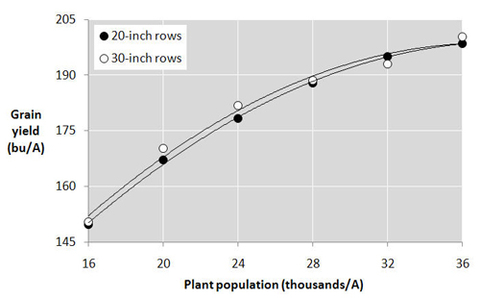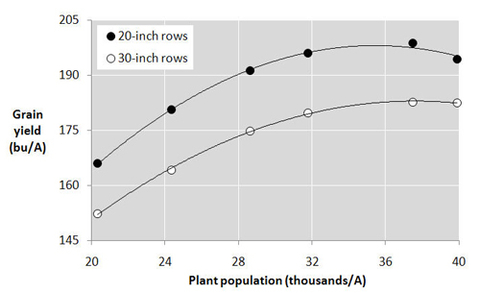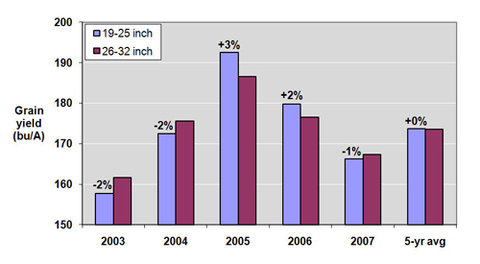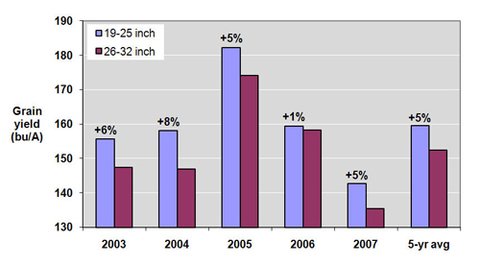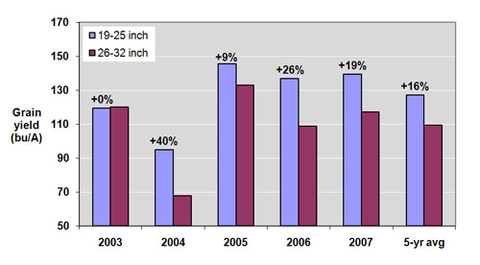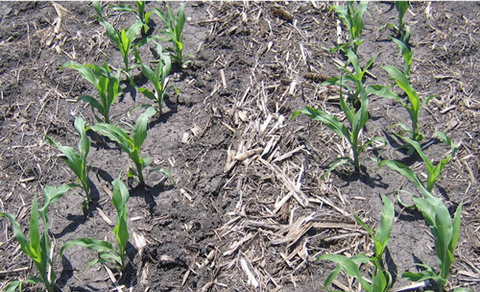Quick facts
-
Corn grain yield increases of up to 7 to 9 percent have occurred in 20-inch rows when directly compared to 30-inch rows. However, yield increases with narrow rows have not always occurred.
-
The economically optimal plant population for corn is similar among row widths.
-
Little evidence suggests row width should influence decisions about hybrid selection.
-
Farm business management records indicate that average corn grain yield with 19- to 25-inch rows was 0, 5 and 16 percent greater than 26- to 32-inch rows in southern, west-central and northwest Minnesota, respectively.
-
Corn producers reported virtually equal or lower average machinery costs for 19- to 25-inch rows, compared to 26- to 32-inch rows.
Producing corn in narrow rows can increase grain yield by as much as 7 to 9 percent in Minnesota. However, yield increases do not always occur.
Generally, the farther north the grower, the more likely that narrow rows will increase yields.
Analyzing farm financial records from Minnesota corn growers indicate higher average yields for 19- to 25-inch rows, compared to 26- to 32-inch rows, in west-central and northwest Minnesota. Results were inconsistent in southern Minnesota.
Records also reveal that average machinery costs were virtually equal or lower for growers planting corn in 19- to 25-inch rows, compared to 26- to 32-inch rows.
Grain yield considerations
The impact of row width on corn grain yield varies.
However, most agree yield increases due to row widths narrower than 30 inches are greater and more consistent as one moves farther north.
Reported yield improvements with narrow rows in the northern – but not the central or southern – Corn Belt regions have been attributed to the shorter growing season in the north. This increases the need for earlier-maturing hybrids.
Earlier-maturing hybrids produce fewer leaves and require slightly less time from emergence to silking. This means less leaf area for intercepting sunlight, compared to the longer-season hybrids grown in the south.
Planting corn in narrow rows leads to more equal plant spacing, which, in theory, helps minimize competition among plants for water, nutrients and light.
When significant, yield-limiting factors are present, it’s more likely that corn grown in narrow rows will increase yield.
Regional comparisons
Research conducted in Minnesota illustrates the potential yield increase of planting corn in narrow rows, although results have not always been consistent.
In one set of trials, corn yield was 7 to 8 percent greater in 20-inch rows than in 30-inch rows when averaged over three years at each of three locations (Table 1).
Trials conducted in Lamberton and Waseca from 2005 to 2007 did not see a yield advantage (Figure 1). But experiments conducted at these same locations in 2008 showed yield was 9 percent greater in 20-inch rows than in 30-inch rows. This yield increase was consistent across the four hybrids and six plant populations used at both locations (Figure 2).
Table 1: Percent yield increase with narrow rows
| Location | 20'' vs. 30'' yield increase: 1992 | 20'' vs. 30'' yield increase: 1993 | 20'' vs. 30'' yield increase: 1994 | 3-year average | 3-year average bushels per acre (bu/a) |
|---|---|---|---|---|---|
| Lamberton | 7% | 15% | 5% | 7% | 136 vs. 106 bu/a |
| Morris | 7% | -2% | 11% | 8% | 114 vs. 106 bu/a |
| Waseca | 10% | 10% | 4% | 8% | 157 vs. 146 bu/a |
Plant population
Many studies have evaluated whether to increase plant population when switching to narrow-row corn. Yield has typically been optimized at a similar plant population, regardless of row spacing.
Corn response to plant population was similar for both 20- and 30-inch rows, in Lamberton and Waseca from 2005 to 2008 (Figures 1 and 2).
Hybrid selection
There is little evidence indicating whether row width should influence decisions about hybrid selection. The majority of research conducted in the northern Corn Belt has found no interaction between row spacing and hybrid. Hybrids that performed well in 30-inch rows also performed well in narrow rows.
Grain moisture
Research conducted by the University of Minnesota in southern Minnesota from 2005 to 2008 found row width does not significantly influence grain moisture at harvest (Table 2).
In these trials, harvest moisture between 20- and 30-inch rows never differed more than one percentage point.
Table 2: Corn grain moisture at harvest, by row width
| Year | Lamberton, 20-inch row | Lamberton, 30-inch row | Waseca, 20-inch row | Waseca, 30-inch row |
|---|---|---|---|---|
| 2005 | 17.0% | 17.1% | 16.0% | 15.4% |
| 2006 | 14.2% | 14.4% | 17.2% | 16.2% |
| 2007 | 14.5% | 14.4% | 14.5% | 14.6% |
| 2008 | 15.5% | 16.7% | 16.8% | 17.3% |
| 4-yr. average | 15.3% | 15.7% | 16.1% | 15.9% |
Silage yield and quality
Corn growers in the northern United States consistently report silage yield increases for corn grown in 15- or 20-inch rows, compared to 30-inch rows.
Reported increases in silage yield due to narrow rows have ranged from 4 to 9 percent (Table 3).
Row width does not influence silage quality or the optimum plant population with regard to silage yield and quality.
Table 3: How corn silage yield responds to row width in various university trials
| Location | Site-years evaluated | Row widths compared (inches) | Increase in silage yield with narrow rows | Source |
|---|---|---|---|---|
| Michigan | 2 | 15 vs. 30 | 5% | Widdicombe and Thelen |
| New York | 3 | 15 vs. 30 | 4% | Cox et al. |
| New York | 2 | 15 vs. 30 | 7% | Cox and Cherney |
| New York | 9 | 15 vs. 30 | 4% | Cox and Cherney |
| New York | 2 | 15 vs. 30 | 7% | Cox et al. |
| Pennsylvania | 10 | 15 vs. 30 | 9% | Roth |
| Wisconsin | 12 | 15 or 20 vs. 30 | 7% | Rankin |
Weed control
Weeds and narrow-row soybean
Most soybean research shows narrow rows lead to quicker canopy closure, lower quantities of light reaching the soil surface and reduced weed emergence later in the season.
Narrow rows can enhance weed control in soybean, particularly since glyphosate, the leading herbicide used in soybean, has no residual activity.
Weeds and narrow-row corn
Results from weed management studies in narrow-row corn are less conclusive.
A research review across the United States published by Crop Management found narrow row widths provided better late-season weed control than 30-inch rows only 24 percent of the time (12 of 50 site-years).
In the research reviewed, differences in light penetration through the crop canopy between narrower rows and 30-inch rows were not always evident, and appeared to diminish as the season progressed.
Row cultivation
Historically, growers have cited the difficulty or inability to perform row cultivation after crop emergence as a disadvantage of narrow-row corn.
While growers have recently shifted away from row cultivation as a weed-control tactic, this practice may become more popular if the incidence of hard-to-control or glyphosate-resistant weeds increases.
If growers want to perform cultivation in corn, a narrow-row production system could be problematic.
Cost considerations
Tires and rims: To adapt existing tractors to narrow rows, growers would likely need to replace tires and rims. Expect greater costs for narrow-row tires and rims compared to those set up for 30-inch rows.
Planter: Narrow-row planters may cost more than 30-inch-row planters, as growers would need more planter units to cover the same working width.
Combine head: Growers will need a narrow-row corn head, unless switching from 30-inch rows to twin-rows. Many growers have attempted to harvest corn planted in 15-inch rows using a 30-inch-row combine head, but reported difficulty staying on the row, increased harvest losses and more volunteer corn the following year.
Soil insecticide: Per acre costs could increase for soil insecticide used at planting, as soil insecticide is applied on a per-row basis. Check the product label for application rates by row width so you don’t exceed the maximum rate per acre.
Starter fertilizer: Per acre costs for starter fertilizer applied at planting would increase since application rates are on a per-row basis.
Financial results by row width
Analyzing farm financial data from growers throughout Minnesota provides an indication of corn performance and machinery costs for narrow rows compared to 30-inch rows.
This self-reported information is from growers using farm business management associations with the University of Minnesota and the Minnesota State Colleges and Universities System. FINBIN, the financial database developed by the Center for Farm Financial Management, stores the information.
When reporting information, growers were asked to select a row width category for each field.
Below we report the FINBIN-generated results for the 19- to 25-inch and 26- to 32-inch row width categories for southern (includes the southwest, south-central and southeast regions), west-central and northwest Minnesota. Information represents 33, 16 and 15 counties, respectively.
Note the information does not have an equal number of farms within each row-width category, and participants were not exactly the same over the years. But the information offers a reliable snapshot of how narrow-row systems have performed for producers across the state, along with the associated machinery costs, compared to 30-inch rows.
Individual grower information is strictly protected and unavailable through FINBIN. A minimum number of farms must meet the categorical criteria to generate a report.
Machinery costs
Table 4 reports average machinery costs per acre for 2005 to 2007.
In two of three years in southern and west-central Minnesota, the 19- to 25-inch group reported lower machinery costs per acre than the 26- to 32-inch group. Differences ranged from $0.75 to $12.02 per acre.
In northwest Minnesota, the opposite occurred, with lower reported machinery costs for the 26- to 32-inch group in two of three years.
Compared to the 26- to 32-inch group, the average machinery cost per acre over three years for the 19- to 25-inch group was lower in southern and west-central Minnesota and slightly higher in northwest Minnesota.
Factors such as equipment age, how long growers had the equipment and whether growers shared the equipment across other crops in the rotation are unknown, and likely contributed to the observed differences.
Table 4: Average machinery costs by region and row width
| Year | Southern Minnesota: 19- to 25-inch rows | Southern Minnesota: 26- to 32-inch rows | West-central Minnesota: 19- to 25-inch rows | West-central Minnesota: 26- to 32-inch rows | Northwest Minnesota: 19- to 25-inch rows | Northwest Minnesota: 26- to 32-inch rows |
|---|---|---|---|---|---|---|
| 2005 | $85.17 | $79.94 | $77.76 | $77.01 | $71.53 | $87 |
| 2006 | $81.52 | $85.48 | $75.48 | $79.71 | $99.26 | $88.56 |
| 2007 | $89.73 | $96.91 | $80.39 | $92.41 | $89.96 | $83.18 |
| 3-yr. average | $85.47 | $87.44 | $77.88 | $83.04 | $86.92 | $86.25 |
Corn grain yield by region
In southern Minnesota, 19- to 25-inch rows had greater corn grain yields than 26- to 32-inch rows in two of five years from 2003 to 2007. But the five-year average was equal (Figure 3).
In west-central Minnesota, 19- to 25-inch rows consistently had 1 to 8 percent higher corn yields than 26- to 32-inch rows from 2003 to 2007. This resulted in an average advantage of 7 bu/A (Figure 4).
In northwest Minnesota, yield was never lower for 19- to 25-inch rows compared to 26- to 32-inch rows. An advantage to narrow rows occurred in four of five years (Figure 5). From 2003 to 2007, 19- to 25- inch rows in northwest Minnesota had greater yield by an average of 18 bu/A, compared to 26- to 32-inch rows.
Interpret these results with caution, because they do not directly compare between row widths. But they do indicate a greater potential to increase yield with narrow rows as one moves north.
Twin-row corn
A variation of narrow-row corn is twin-row corn, in which growers plant corn in row pairs 6 to 8 inches apart, with 30 inches between the centers of row pairs.
To date, there has been little research comparing corn grown in twin-rows and 30-inch rows in Minnesota.
Yields
Growers adopting the twin-row practice report increased yields, enhanced weed control due to faster canopy closure and stronger stalks.
If a twin-row configuration enhances the performance of other crops in the rotation, it could enhance the overall profitability of this row configuration.
Further research is needed to determine the agronomic effects and cost-effectiveness of this practice in Minnesota.
Costs
One advantage of twin-rows over 20- to 22-inch rows is that growers can use a standard 30-inch combine head to harvest twin rows.
Other costs, such as starter fertilizer and soil insecticide applied at planting, would likely increase for twin-row configurations compared to 30-inch rows, as seen with the more conventional narrow-row situations.
Interest and impact
With narrow profit margins, corn growers need production practices that increase yield and reduce variable performance across environments.
This holds particularly true in the northern Corn Belt, where the shorter growing season and cooler air temperatures limit crop yield potential.
Narrow rows are one possible way to increase yield and reduce variability in yield.
National row widths
According to field surveys conducted by the USDA National Agricultural Statistics Service in, the average row width for grain corn in Minnesota in 2016 was 28.9 inches, with 4.6 percent of the acreage in row widths narrower than 20.5 inches.
Although the majority of corn in Minnesota is planted in 30-inch rows, results indicate that a significant number of acres are planted in narrow rows (less than 30 inches wide). In comparison, the average row width for grain corn was estimated as 30.4 inches for Iowa, 30.5 inches for Wisconsin and 31 inches for Nebraska.
Local interest
Recent interest in narrow-row corn (typically in row widths of 22, 20 or 15 inches) has been driven in part by the desire to use one planter across more than one crop.
A 22-inch row width, for example, allows sugarbeet growers to use the same planting equipment for sugarbeet, corn and soybean.
Planting corn in rows narrower than 20 inches is rare, due in part to difficulty with postemergence herbicide applications and harvest.
Much of the narrow-row corn production research in the Corn Belt was conducted in the 1990s or earlier, prior to the availability of transgenic hybrids with resistance to herbicides and insects.
Corn plant populations have also increased over time, emphasizing the need to revisit the effects of row width on corn production and economic return.
Bradley, K.W. (2006). A review of the effects of row spacing on weed management in corn and soybean. Crop Management, 5(1). A Review of the Effects of Row Spacing on Weed Management in Corn and Soybean
Center for Farm Financial Management. (2009). FINBIN Farm Financial Database [Data set]. Available at Welcome to FINBIN.
Coulter, J.A. (2018). Optimal plant population for corn in Minnesota.
Cox, W.J., Hanchar, J.J., Knoblauch, W.A. & Cherney, J.H. (2006). Growth, yield, quality, and economics of corn silage under different row spacings. Agronomy Journal, 98, 163-167. Growth, Yield, Quality, and Economics of Corn Silage under Different Row Spacings
Cox, W.J. & Cherney, D.J.R. (2002). Evaluation of narrow-row corn forage in field-scale studies. Agronomy Journal, 94, 321-325.
Cox, W.J. & Cherney, D.J.R. (2001). Row spacing, plant density, and nitrogen effects on corn silage. Agronomy Journal, 93, 597-602. Row Spacing, Plant Density, and Nitrogen Effects on Corn Silage
Cox, W.J., Cherney, D.R., & Hanchar, J.J. (1998). Row spacing, hybrid, and plant density effects on corn silage yield and quality. Journal of Production Agriculture, 11, 128-134.
Lee, C.D. (2006). Reducing row widths to increase yield: Why it does not always work. Crop Management, 5(1). Reducing Row Widths to Increase Yield: Why It Does Not Always Work
Porter, P.M., Hicks, D.R., Lueschen, W.E., Ford, J.H., Warnes, D.D., & Hoverstad, T.R. (1997). Corn response to row width and plant population in the northern Corn Belt. Journal of Production Agriculture, 10, 293-300. Corn Response to Row Width and Plant Population in the Northern Corn Belt
Rankin, M. (2000). Narrow row corn silage update.
Roth, G.W. (1997). Potential of narrow row corn production in Pennsylvania. Agronomy Facts 52.
USDA-NASS. (2008). Agri-View, AV-21-08.
Widdicombe, W.D., & Thelen, K.D. (2002). Row width and plant density effect on corn forage hybrids. Agronomy Journal, 94, 326-330. Row Width and Plant Density Effects on Corn Grain Production in the Northern Corn Belt
Reviewed in 2021


